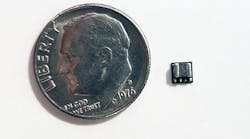When it comes to reducing the size and increasing the efficiency of power components, products introduced at this year's Applied Power Electronics Conference (APEC) last week demonstrate that there are many ways to skin the cat. Here’s a look at some new product introductions.
Power Integrations, known for its energy-efficient power conversion products, announced its latest chipset for TV and monitor display power supplies. Under pressure to meet the new Energy Star specification taking effect in July of this year, manufacturers are looking for solutions and this chipset, which Power Integrations says boosts overall power efficiency, may fill the bill. It replaces the ACDC and DCDC converters with a single-stage, flyback technology.
The component pairs the company's InnoMux controller IC with an InnoSwitchTM3-MX isolated switcher IC to independently measure the load requirement of each of the outputs, which can include logic, audio or LED. The chip is designed to deliver the right amount of power to each. Two reference designs are available and Power Integrations says samples will be available starting in second quarter of the 2019 calendar year.
Murata announced what it says is the world’s smallest, most efficient, fully integrated 6A buck regulator. The company says its 12 mm x 9 mm x 2 mm footprint is 25% smaller than competitive solutions and features a 30% lower profile. The innovation that made this possible is a two-stage power conversion architecture developed by MIT spin-out Arctic Sand, which Murata’s semiconductor division pSemi acquired in 2017.
This architecture simultaneously reduces the size of passive components and increases efficiencies by 90% percent for 12V input to 1.8V output--more than 5 percent higher than competing products says Murata. Samples will be available starting in August 2019.
TDK Corporation announced its latest µPOL DC-DC converters, which it says are the industry’s smallest and highest power density point-of-load solutions for applications such as big data, machine learning, artificial intelligence, and 5G small cells. The FS series benefits from the integration of the IC and inductor together, rather than the more typical configuration of a side-by-side discrete integrated circuit (IC) and discrete inductor (L), and a need for fewer external components.
Measuring in at 3.3 x 3.3 x 1.5 mm, the parts can deliver a high-density solution of 1 watt per mm3, at 50% the size of comparable parts.
With the recent opening of a North American distribution arm, German device manufacturer Elektro-Automatik is bringing products like its PSB 10000 4U bi-directional DC source and regenerative electronic power supply and load to the US market, where it already has a foothold in the EV ecosystem with manufacturers like Tesla.
The PSB is able to recycle the loaded energy back to the grid at approximately 95% efficiency, according to Eric Turner, General Manager, Elektro-Automatik North America. That produces what Turner says is an industry-leading power density in a single 4U rack mount chassis. The result is lower operational costs, he added.
